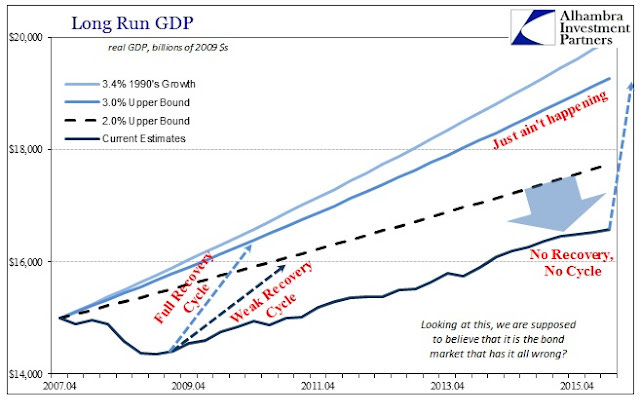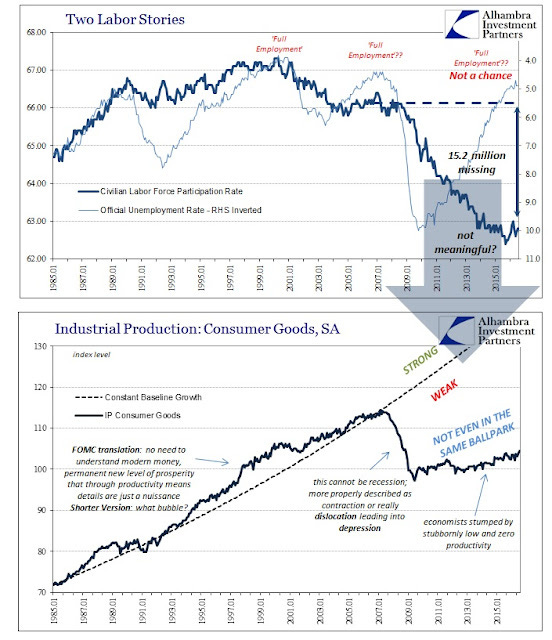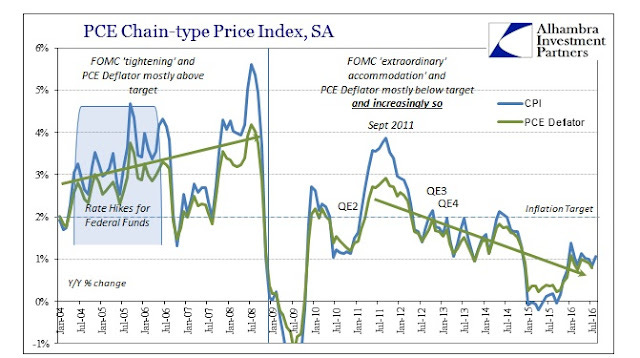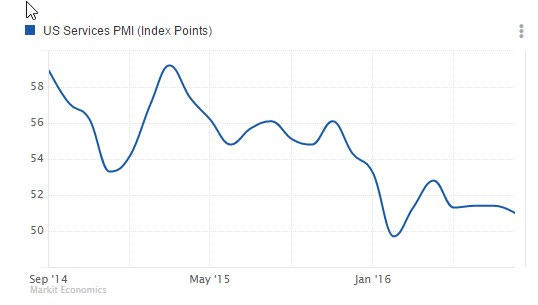Declining Global Money Supply Taking World Economy With It
Jeffrey Snider at Alhambra Partners is far smarter than any of the over-educated PhDs at the Federal Reserve. He's been writing for a long time saying correctly that the world's central bankers "don't know what they are doing." Borrowing heavily from Jeff, I wrote a blog post of the same name here.
He's sounding the alarm that now we're really in more of an economic depression, especially in comparison to the deviation and duration of economic trends that existed up to the financial crisis in 2008. It's gotten worse in the past 2 years. Economic growth across the world is in noticeably fading with no end in sight. US and EU growth is down to 1% or so and still decaying. Nearly all of the commodity producing countries are in recession as oil and commodity prices collapse. World trade is now declining. Chinese imports and exports are down double digits in the past two years and no end in sight. No one except Jeffrey Snider has a plausible explanation.
In a brief video below (found here), he explains as concisely as possible what he means:
Here's his graphical evidence of a "long period of economic stagnation" in the US -- from his blog posts at Alhambra Partners. Stagnation has turned into decline in most emerging markets.

Serious and Long-Lasting Deviation In GDP From Previous Trends. Even after $9T in New Debt Spending (With Nothing To Show For It.) The "Eurodollar,"including all of it's derivatives; swaps, repos, reverse repos, forwards, etc.; the real money supply to the world, has been in decay since about 2011 to the present day. Parentheses around "eurodollar" means it's the aggregate of credit default swaps, interest rate swaps, currency forwards/swaps, repos/reverse reps and other derivatives. Janet Yellen, Bernanke, Allen Greenspan, and the minions of US Federal Reserve PhDs have been oblivious to this financial phenomenon for the entire rise and fall of the "eurodollar." Why else has Yellen been so obviously confused by her forecasts and failures? The problem is that economists are not trained in world wholesale finance.
Here's the 20 year history of the rise and fall of the REAL money supply to the world -- especially to China and the emerging markets. In recent years the world's real money supply is decaying rapidly and taking the world's economy with it.

The "Eurodollar" is unregulated liquidity that exists on (and off) the large bank balance sheets in Europe and the US. There are nearly no dollars backing these instruments. It's nearly pure leverage and very unstable in times of crisis -- as we found out in 2008. That's why the banks are now fleeing these markets in increasing desperation. It's too risky. "Eurodollars" are literally the antithesis of sound money. It's like "internet money." It's pure leverage with no real "backing" except faith in the money center banking system. But faith in the European banking system is dropping like a rock, especially this year. Major EU bank stock prices are plummeting this year, indicating declining faith in these institutions. Fear is rising as shown by rising LIBOR rates.
Here's the effect of both the rise AND decline of the real global money supply:

Shrinking "Eurodollar" Money Supply Causing Worldwide Economic Stagnation. No One Notices. The US labor market and employment "recovery" has been weak and not as strong as the administration has proclaimed. For the first time ever, job gains are not keeping up with population growth. The so-called economic recovery from the 2008 financial crisis is not anything close to a "real recovery" when you consider Labor. Still think the unemployment rate is really 4.9%?

Labor Participation at 40 Year Lows As Job Gains Fails to Keep Up With Population Growth. Also, Do You See Any Recovery Of Industrial Production? Jeff Snider goes on to say:
According to Snider, there is a realistic chance that there is an intractable structural monetary problem that is leading to economic problems that central banks don’t seem to be able to solve or even recognize. When there are problems in liquidity, LIBOR rises. Looking behind the curtain, Snider finds monetary contraction, not monetary expansion.
There are other implications as well, perhaps more important than just investing. If this is indeed a depression, Snider says, “Historically periods of prolonged economic stagnation, lead to some of the worst types of historical events, usually social disorder, political upheaval, all those kinds of things.”
Most of the economic data after the 2008 data is poor, including Industrial Production. The US Federal Reserve's goals of stronger growth and higher inflation through repeated QEs has not worked. They don't know what they're doing!

Two Years of Falling Industrial Production Begins to Resemble Recession or Depression

Bernanke and Yellen's Inflation Targeting A Total Failure Now
US manufacturing's decline in the past two years will eventually be reflected in declines of the larger service sector. It's happening now. Retail sales, still positive, but still hovering near recessionary levels.

US Services PMI is Trending Down and Now Following Industrial Production Declines. Soon Contracting?
Until this problem in money markets is recognized, the economic damage continues to accumulate for a longer and longer period of time. Already, the decay of the world economy is now 2 years in duration. Money markets are now in turmoil due to decreasing liquidity and monetary "tightness." LIBOR rates are rising indicating tightness in wholesale money markets for the banks. Falling liquidity is likely to seriously affect stock and bond markets too. There have already been steep stock market liquidation periods like we saw in August 2015. Expect more economic pain and market turmoil in the very near future.


